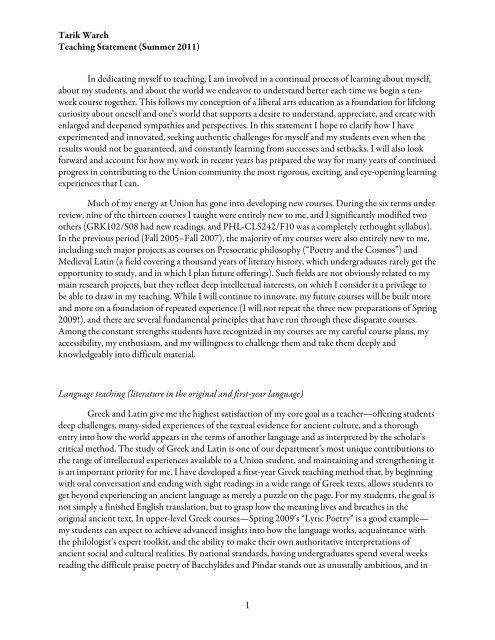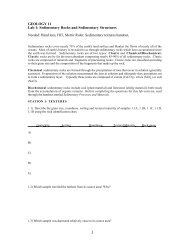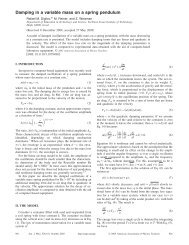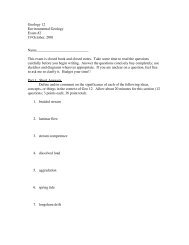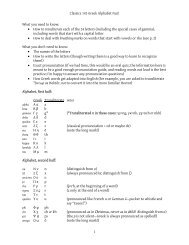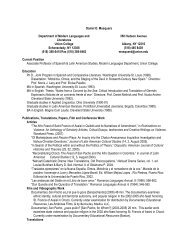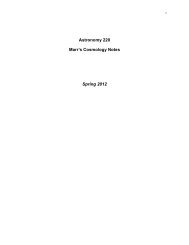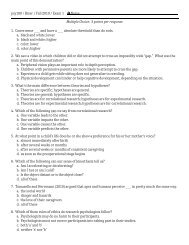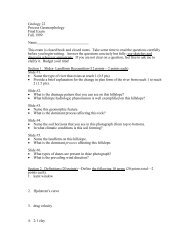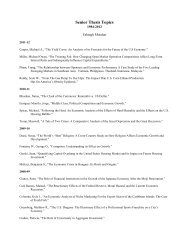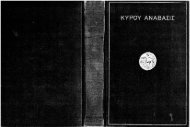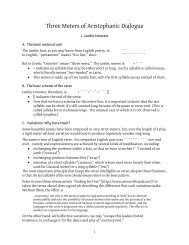Tarik Wareh Teaching Statement (Summer 2011) 1 ... - Union College
Tarik Wareh Teaching Statement (Summer 2011) 1 ... - Union College
Tarik Wareh Teaching Statement (Summer 2011) 1 ... - Union College
You also want an ePaper? Increase the reach of your titles
YUMPU automatically turns print PDFs into web optimized ePapers that Google loves.
<strong>Tarik</strong> <strong>Wareh</strong><br />
<strong>Teaching</strong> <strong>Statement</strong> (<strong>Summer</strong> <strong>2011</strong>)<br />
In dedicating myself to teaching, I am involved in a continual process of learning about myself,<br />
about my students, and about the world we endeavor to understand better each time we begin a tenweek<br />
course together. This follows my conception of a liberal arts education as a foundation for lifelong<br />
curiosity about oneself and one’s world that supports a desire to understand, appreciate, and create with<br />
enlarged and deepened sympathies and perspectives. In this statement I hope to clarify how I have<br />
experimented and innovated, seeking authentic challenges for myself and my students even when the<br />
results would not be guaranteed, and constantly learning from successes and setbacks. I will also look<br />
forward and account for how my work in recent years has prepared the way for many years of continued<br />
progress in contributing to the <strong>Union</strong> community the most rigorous, exciting, and eye-opening learning<br />
experiences that I can.<br />
Much of my energy at <strong>Union</strong> has gone into developing new courses. During the six terms under<br />
review, nine of the thirteen courses I taught were entirely new to me, and I significantly modified two<br />
others (GRK102/S08 had new readings, and PHL-CLS242/F10 was a completely rethought syllabus).<br />
In the previous period (Fall 2005–Fall 2007), the majority of my courses were also entirely new to me,<br />
including such major projects as courses on Presocratic philosophy (“Poetry and the Cosmos”) and<br />
Medieval Latin (a field covering a thousand years of literary history, which undergraduates rarely get the<br />
opportunity to study, and in which I plan future offerings). Such fields are not obviously related to my<br />
main research projects, but they reflect deep intellectual interests, on which I consider it a privilege to<br />
be able to draw in my teaching. While I will continue to innovate, my future courses will be built more<br />
and more on a foundation of repeated experience (I will not repeat the three new preparations of Spring<br />
2009!), and there are several fundamental principles that have run through these disparate courses.<br />
Among the constant strengths students have recognized in my courses are my careful course plans, my<br />
accessibility, my enthusiasm, and my willingness to challenge them and take them deeply and<br />
knowledgeably into difficult material.<br />
Language teaching (literature in the original and first-year language)<br />
Greek and Latin give me the highest satisfaction of my core goal as a teacher—offering students<br />
deep challenges, many-sided experiences of the textual evidence for ancient culture, and a thorough<br />
entry into how the world appears in the terms of another language and as interpreted by the scholar’s<br />
critical method. The study of Greek and Latin is one of our department’s most unique contributions to<br />
the range of intellectual experiences available to a <strong>Union</strong> student, and maintaining and strengthening it<br />
is an important priority for me. I have developed a first-year Greek teaching method that, by beginning<br />
with oral conversation and ending with sight readings in a wide range of Greek texts, allows students to<br />
get beyond experiencing an ancient language as merely a puzzle on the page. For my students, the goal is<br />
not simply a finished English translation, but to grasp how the meaning lives and breathes in the<br />
original ancient text. In upper-level Greek courses—Spring 2009’s “Lyric Poetry” is a good example—<br />
my students can expect to achieve advanced insights into how the language works, acquaintance with<br />
the philologist’s expert toolkit, and the ability to make their own authoritative interpretations of<br />
ancient social and cultural realities. By national standards, having undergraduates spend several weeks<br />
reading the difficult praise poetry of Bacchylides and Pindar stands out as unusually ambitious, and in<br />
1
<strong>Tarik</strong> <strong>Wareh</strong><br />
<strong>Teaching</strong> <strong>Statement</strong> (<strong>Summer</strong> <strong>2011</strong>)<br />
“Lyric Poetry” I helped the students expand their comfort zone to achieve this. I believe those students<br />
of ours who have gone on to become Latin teachers and Ph.D. students in comparative literature and<br />
Classics got an important part of what they needed in such courses. In the same way, my individual<br />
research students have undertaken challenges beyond the normal curriculum, including<br />
interdisciplinary connections to such areas as mathematics, computer science, and Near Eastern history<br />
and religions.<br />
I have reached a wider audience in my two advanced Latin courses so far. In my Winter <strong>2011</strong><br />
course on Virgil’s Aeneid, students worked hard on traditional language skills but undertook a wide<br />
variety of projects intended to make them think in other, new ways. Students stretched their linguistic<br />
muscles by participating in the Latin Dependency Treebank project (an online framework for<br />
diagramming sentences to create a queryable database of syntactic structures); this involved the<br />
considerable challenge of learning the terms of dependency grammar, which was rewarded when we<br />
later were able to prove to ourselves the value of such advanced analytic terms as “verbal attribute” and<br />
“non-governed complement.” Even in a case like this—an experiment I probably will not repeat because<br />
of its sheer complexity—I am in no doubt that the students who participated in the experiment will<br />
have lifelong insights into how language works because of it. Students in this course also got ample<br />
inspiration and encouragement to synthesize our material in less purely linguistic ways. I was<br />
particularly pleased to see high-quality projects in which students explored how Virgil’s poetic lens as<br />
the author of an epic of national identity could be related to other historical experiences (the burning of<br />
the Schenectady Stockade) and works of art (from Beatnik poetry to the films of David Lynch).<br />
Another student’s project, “Coppola’s Godfather: Echoes of Virgil’s Aeneid in The Godfather,” was later<br />
presented to a regional audience at Hamilton <strong>College</strong>. I look forward to playing a greater role in coming<br />
years in teaching beginning Latin, where the larger student audience demands a special blend of<br />
popularizing fun and linguistic precision.<br />
Recent new contributions to general education: FYP and SRS<br />
I measure my successes according to the evidence that I have enabled and provoked students to<br />
reach high standards and challenge themselves. By this measure, my Winter <strong>2011</strong> First Year<br />
Preceptorial (“The Author as Sage”) can count several successes, together with indications for future<br />
improvements, and serves as a good example of how I have confronted myself and students with<br />
demands that awaken us to new possibilities. I voluntarily sought FYP as an important opportunity,<br />
despite its well-known challenges.<br />
I wanted the first-year students to understand from the beginning of their college experience<br />
that their education can be more than meeting narrowly prescribed expectations, a kind of performance<br />
in which the students are often well trained and most comfortable. For this reason I included in the<br />
course opportunities for them to choose their own direction and to serve as each other’s collaborators<br />
and discussants. This style of learning was made possible by the small class size of FYP and led to the<br />
development of ideas and arguments that better realized their own commitments and expectations of<br />
themselves. I believe that what students create to share with their fellow students not only enriches the<br />
academic atmosphere of the campus (it is a reason why I will be pushing in the future, not only for in-<br />
2
<strong>Tarik</strong> <strong>Wareh</strong><br />
<strong>Teaching</strong> <strong>Statement</strong> (<strong>Summer</strong> <strong>2011</strong>)<br />
class self-presentation, but also campus-wide class performances) but also makes them more actively<br />
involved in self-education as a pursuit not confined to their classes. Students had two weekly<br />
assignments for peer response—a weekly paragraph of evidence-based argument for in-class<br />
“workshopping” and weekly contributions to our “Emerson Aphorism Project.” The Emerson project<br />
(documented in the dossier) was less clearly leading to the kind of discussion and experimentation that<br />
would contribute to a higher standard of writing in the papers, so I substituted a close-reading exercise<br />
for it halfway through the term. The paragraph workshops, however, led us into impressively wideranging<br />
in-class interpretation and analysis of often difficult readings. They seemed to solve at a stroke<br />
the problem of sterile discussions that can plague this kind of required course. When I saw students<br />
debate and develop their ideas into an interesting discussion with multiple points of view, I considered<br />
this the best kind of feedback for our purposes, even if, despite my careful participation, it was not the<br />
kind of feedback some students expected.<br />
My FYP deliberately offered students some quite challenging readings, including essayists with<br />
sweeping judgements about their world (from Simone Weil to Ralph Waldo Emerson, from Nietzsche<br />
to Theodore Parker, from David Foster Wallace to William James). Its premise was to confront<br />
students with a kind of writing they were very unlikely to have been interested in before. Yet in our<br />
discussions I saw students able to appreciate what Theodore Parker’s heterodox construction of a<br />
religion without creed and dogma had contributed to Martin Luther King’s “How Long, Not Long”<br />
speech, and by the time the class had reached the final reading, Kerouac’s On the Road, a novel that<br />
could easily have been read superficially by a class of freshmen as a glamorous and reckless adolescent<br />
experience, we were able to plumb the spiritual and meditative depths of this work with recourse to<br />
sources such as Whitman’s poetry.<br />
The real test of these ventures was in the longer-form drafts and essays written for my detailed<br />
critique. Here I see significant successes resulting from a course design in which I facilitated students’<br />
ability to find their own intellectual paths. In one final paper, “Anti-Wagnerism: How Progressive<br />
Metal is Saving the Music Industry,” the student, a prospective chemistry major, without any prior<br />
knowledge of German philosophy or nineteenth-century musical culture, was able to enter deeply and<br />
imaginatively enough into the problems and arguments of Nietzsche’s The Wagner Case to sustain her<br />
own original and well-argued cultural critique and reflection. Her achievement of a committed<br />
viewpoint on, and argument about, her own world is very likely to stick with her beyond the course and<br />
fuel her serious curiosity as a lifelong learner. To make this kind of progress more concrete, I have<br />
included in my teaching dossier two sets of “before” (paper #1, week 4) and “after” (paper #2, week 7)<br />
writing from this FYP. These are both from students whose interests lay far afield and whose first<br />
papers did not show their potential and promise as writers (one had felt quite discouraged after<br />
receiving the first paper back), but who were led by the design of the course to experiment ambitiously<br />
with much more specific evidence-based arguments. These second papers showed an acquired<br />
motivation to take seriously the ideas of John Ruskin—one of the authors whom I included in the<br />
course in order to force students outside of their literary and intellectual comfort zone. For students<br />
like these, this resulted in growth of their critical faculties and imaginative sympathies. Their<br />
commitment to their arguments about Ruskin shows a connection forged between our class’s literary<br />
discussions and arguments and their ongoing reflections on their own lives and worlds. I believe that,<br />
having experienced this connection, they will be opened up to a more complete experience of the liberal<br />
3
<strong>Tarik</strong> <strong>Wareh</strong><br />
<strong>Teaching</strong> <strong>Statement</strong> (<strong>Summer</strong> <strong>2011</strong>)<br />
arts education that lies before them. FYP is a difficult challenge, but I will be coming back to it, again by<br />
choice, in Winter 2012, with significant changes (in readings and the overall structure of the course and<br />
its assignments), but aiming to enhance the success of its fundamental ideas.<br />
My Spring <strong>2011</strong> Sophomore Research Seminar (“The Ancient Historians”) was a more difficult<br />
assignment (resulting from last-minute changes in topic, format, and instructor), but I quickly<br />
developed a highly organized framework for student research into ancient historiography, with<br />
collaborative online bibliographies and interpretive brainstorming (using a course wiki, something I<br />
first tried the previous term for FYP), one-on-one feedback and consultations on the final project, and<br />
in-class workshopping of draft ideas on each week’s readings. In the final papers, I was able to see<br />
students who had chosen not only their own path of argument through the primary and secondary<br />
sources concerning the ancient historians, but who had also turned their hard work on the ancient<br />
historians into new perspectives on more recent issues, including twentieth-century international<br />
relations; the political sociology of fear as a force capable of creating unity and disunity; art criticism as a<br />
source of insight into historians’ use of emotional expressionism; partisan political propaganda; and the<br />
connections between contemporary U.S. practices surrounding death and ancient rulers’ pursuit of a<br />
“legacy.” I mention these as successes because I believe the enduring value of humanities studies includes<br />
their ability to change the student as an interpreter and analyzer of their world.<br />
Embracing challenge and involving students in my research questions: Aristotle<br />
Given my commitment to taking seriously students’ capacities for insight and understanding, I<br />
am interested in opening up new areas of challenge in the <strong>Union</strong> curriculum. Here my new course on<br />
Aristotle, taught twice so far in very different versions (Spring 2008 and Fall 2010), is a good example.<br />
The course drew a range of curious students with very different academic interests—from mathematics<br />
and science to literature and philosophy—who were plunged into the complexities of Aristotelian<br />
theory. Nothing would have been easier than avoiding the challenge and confusion of dealing with areas<br />
such as metaphysics and the philosophy of mind, but to do so would make the curriculum poorer and<br />
miss an opportunity to make visible the less obvious interconnections between classical antiquity and<br />
everything else students study at <strong>Union</strong>. For example, this course has been one avenue for encouraging<br />
interdisciplinary thought around the subject of biological theory, thus inspiring future courses and<br />
collaborations (see below). The difficult (but important) question that persists for me as I develop the<br />
third iteration of this course will be how to meet a general student audience with material of this kind.<br />
<strong>Teaching</strong> Aristotle has also allowed me to share my scholarly experience more fully than has<br />
otherwise been possible outside of language courses. This is not only because of the kind of classroom<br />
discussion that results from the difficult and technical nature of the material, over which even experts<br />
disagree. It is also because I have been able to offer students readings and ideas that are highly<br />
appropriate to their own learning path, despite not being the normal fare of undergraduate courses. For<br />
example, in the Spring 2010 version, I reoriented the course toward the discussion of ethics and<br />
incorporated weekly readings from Aristotle’s Protrepticus. This dialogue, in which Aristotle sought to<br />
inspire young people of his time (the ancient equivalent of college students) to give their respect and<br />
devotion to philosophy, is uncommonly relevant and useful in figuring out the connection between<br />
4
<strong>Tarik</strong> <strong>Wareh</strong><br />
<strong>Teaching</strong> <strong>Statement</strong> (<strong>Summer</strong> <strong>2011</strong>)<br />
ethical and metaphysical theory and the more obviously pressing concerns of practical life. Yet the<br />
dialogue survives only in fragments, and it is only because my work had led me to write about the<br />
Protrepticus in my own book, and to become acquainted with the ongoing effort by other scholars to<br />
reorganize the fragments into a more compelling whole, that I was able and willing to find a way for<br />
students to benefit from studying it. The result is that students were able to make intelligent use of a<br />
scholarly reconstruction—in fact, they reported that this was one of the more readable and intelligible<br />
of our texts. They developed informed arguments about how Aristotle sought to borrow from<br />
contemporary rivals such as Isocrates while defending the distinctiveness of his own school’s approach.<br />
In other words, they were able to understand important issues in the history of philosophical thinking<br />
that are still not widely discussed and appreciated by professional scholars.<br />
I am aware that my natural inclination to “go deep” in the classroom carries risks and<br />
challenges. It is normal in my classes that not everything is instantly digestible, and the relationship of<br />
each part to everything else may not become clear as soon or as completely as both I and my students<br />
want. I do strive to compensate for the difficulties that may arise from the way in which I involve<br />
students in honest in-class exploration of difficult subjects. For example, I take measures to give<br />
students a comfortable and regular framework. This is in my mind as I organize the course and<br />
communicate its structure, and it leads me to begin, punctuate, and end our course meetings with<br />
overviews, backward reflections, and anticipations. While very mindful, then, of the importance of<br />
achieving clarity when it is appropriate and possible, I also try to remember that at times a degree of<br />
confusion can indicate a productive grappling with the material, its difficulties, and the range of<br />
contradictory ideas it can provoke. An intriguing recent study by the Harvard physics education<br />
researcher Eric Mazur established the counter-intuitive result that students perform better on problems<br />
in the end when they have passed through the very confusion they typically downgrade on evaluations. 1<br />
Clearly this point has its limits; my personal goal is to maintain the strength of my approach (never<br />
allowing students the easy but illusory feeling of superiority that accompanies an inability to recognize<br />
mistakes and difficulties) while continuing to improve the weaknesses that are not integral to those<br />
successes (clarifying everything, including the structure and planning of our classes). I know this balance<br />
is working the right way when I see—as recently in some of my students’ SRS papers—students who<br />
have initially felt “lost” in the complexity of the material producing ambitious and attentive<br />
interpretations. The goal is not discomfort for its own sake, but precisely to make students comfortable<br />
with the uncertainty humanistic study requires. Students will benefit most from their humanities<br />
studies when they are undeterred from attacking questions that lack perfect answers, confident in the<br />
power of rigorous attention to the evidence and their own ability to use a multi-step argument to create<br />
surprising and satisfying insights into their world and themselves.<br />
Future directions: Performances and collaborations<br />
Courses on less technical and more accessible subjects for the general education audience are a<br />
crucial part of the Classics Department’s mission. Building on my experiences teaching ancient tragedy<br />
1<br />
Eric Mazur, “The scientific approach to teaching: Research as a basis for course design,” keynote and plenary address to the<br />
International Computing Education Research Conference, Providence, R.I., August <strong>2011</strong>.<br />
5
<strong>Tarik</strong> <strong>Wareh</strong><br />
<strong>Teaching</strong> <strong>Statement</strong> (<strong>Summer</strong> <strong>2011</strong>)<br />
(Winter 2008) and comedy (Spring 2009) in translation, I have developed a plan to teach a new course<br />
on ancient drama in performance that will serve this audience and do justice to several of my principles<br />
and goals as a teacher. Previously, I have had students use in-class performances to spur debate about a<br />
text’s meanings and to highlight the difficulties and possibilities that open up when modern readers<br />
encounter ancient cultural artefacts. In the comedy course I took this a step further and had student<br />
groups completely modernize ancient scenes, not only shifting these texts’ obsessive interest in daily life<br />
into the students’ American world, but also identifying how ancient comic techniques could be applied<br />
to our own preoccupations, social tensions, etc. Though a small part of my previous courses, this<br />
assignment gave students a vantage point from which to consider their own cultural landscape: how do<br />
our own entertainments engage—or not engage—with the kinds of questions that excited ancient<br />
audiences? What does this say about our own social, political, and cultural identity?<br />
I anticipate several advantages that will make it worthwhile to develop a course more wholly<br />
oriented to performance questions. First, focusing on a single work and achieving the level of mastery<br />
necessary for a production will give students a motivation to achieve deeper expert knowledge about the<br />
ancient world and the literary practices of our dramatic texts. For example, in a survey course, we may<br />
speak only briefly about the nature of Aristophanes’ choral songs, but their poetic character and<br />
attitude to the audience will be a major topic in a performance-oriented course. Students will read<br />
related works but will have a more concrete mission in doing so: how do they illuminate the distinctive<br />
choices and possibilities of the main work to be produced in performance? While bringing students<br />
closer to ancient realities, this approach will also demand a more creative and committed discussion of<br />
the modern relevance of ancient works—how performers can communicate both the ancient dramas’<br />
cultural difference and distance, and its points of intersection with our own experiences. Finally, while<br />
the course will remain a Classics course graded by Classics standards (i.e., students are graded on the<br />
explanations, arguments, care, and thought that underlie their dramatic approach, not on their skill as<br />
performers), it offers an effective way to persuade a wide variety of students that learning and reflecting<br />
on other cultures can involve a lot more than simply reading books and writing papers. I hope that this<br />
will animate their approach to future courses and assignments, as well as shaping their lifelong learning.<br />
Finally, the class would have the opportunity to share with the whole campus community, in an<br />
amateur performance, the insights that have emerged from their deep engagement with the ancient<br />
material. This will make them accountable to a peer audience while enriching the quality of the<br />
campus’s learning environment.<br />
Similar principles are also applicable to larger courses. For example, in Spring 2012 I will teach<br />
World Mythology, which is likely to be one of the largest courses on campus, taught in an auditorium.<br />
Such large audiences are very challenging, and I have thought a lot based on earlier trial and error about<br />
the right approach. My conclusion is that I can do the most with my own strengths by clearly<br />
communicating to students that each 105-minute period will present them with three “pieces” for<br />
which I will hold them accountable: understanding a reading from an ancient text; understanding an<br />
event or tradition in the modern reception or performance of ancient myth; and understanding a “big<br />
idea” (myth as political propaganda; the common Indo-European inheritance of myths in different<br />
cultures; comic myths as questioning and reinforcing social norms; etc.). This approach is calculated,<br />
again, to get students deeply involved with ancient realities, while fully participating in questions of<br />
their modern relevance, and bringing in accessibly my own expertise on topics they would not be likely<br />
6
<strong>Tarik</strong> <strong>Wareh</strong><br />
<strong>Teaching</strong> <strong>Statement</strong> (<strong>Summer</strong> <strong>2011</strong>)<br />
to learn about from other instructors (for example, Indo-European myth and linguistics). I believe that<br />
these elements will realize significant improvements over the results I experienced when I taught<br />
Classical Mythology in Fall 2006.<br />
Another future direction of growth for which I am well prepared is interdisciplinary courses.<br />
New approaches that involve the matter and methods of philosophy and fine arts are already<br />
interdisciplinary, but I also hope to extend the department’s outreach to the sciences. Up till now, this<br />
has taken a more archeological approach, with courses on engineering and the environment in<br />
antiquity. I would like to move into the more philosophical terrain of ancient medical and biological<br />
theory. The idea of a course in which students would read Dawkins vs. Gould (by a philosopher of<br />
biology) alongside Creationism and its Critics in Antiquity (a series of public lectures by an ancient<br />
philosopher) thrills me. I acknowledge the difficulty of such experiments, and I know they can lead to<br />
roadbumps and results that may not, at first, prove their promise. Even so, I believe that by stretching<br />
the <strong>Union</strong> curriculum into worthwhile new areas in this way, I can offer students intellectual<br />
experiences that will stay with them and live up to our mission to change how they see the world—<br />
despite their being “guinea pigs” the first time.<br />
My teaching has involved direct collaboration with colleagues in several other departments,<br />
including guest lectures in philosophy courses; advising a Theater Department production and<br />
coordinating the Theater Studies cluster; co-advising student research projects with colleagues in<br />
Mathematics (a two-department thesis) and Computer Science (a project that contributed to the NSF-<br />
CPATH grant, was discussed as part of the proposed <strong>Union</strong>/IBM collaborations, and was presented by<br />
the student to a national audience of undergraduates and scholars in Washington, D.C.); and (for Fall<br />
<strong>2011</strong>) serving as the “customer” whose project the Software Engineering course (CSC 360) will work<br />
on. I believe there is every chance of developing these alliances into significant curricular innovations,<br />
possibly including team teaching. I also have promoted these interdisciplinary collaborations to an<br />
extramural audience (in the October 2010 CAAS panel in New Jersey, with Classics colleagues and<br />
<strong>Union</strong> administrators) and maintain a website whose resources have been useful to faraway students<br />
and colleagues.<br />
All of these interdisciplinary connections reflect who I am: a lifelong liberal-arts learner myself.<br />
I appreciate the <strong>Union</strong> <strong>College</strong> community as a place where I can share my manifold enthusiasms and<br />
intellectual projects with a wide range of students and colleagues. In this sense, the non-Classicist parts<br />
of my identity are important to the teacher and scholar I am and can be here: my love of math (which<br />
led me to take a college math course—differential geometry—for the first time the year before I began<br />
teaching at <strong>Union</strong>), my love of languages (including the great majority of those taught at <strong>Union</strong> and<br />
several others besides), my recent determination to teach myself to draw (meeting local artists in the<br />
Arts Building most weeks to stretch myself in a direction that does not come easily to me), my interest<br />
in sociological theory, and my amateur musical interests (which have led me to find out who on campus<br />
wants to talk about Irish jigs, Brazilian song, and Buxtehude cantatas). All of these interests have led me<br />
into deep conversations with colleagues; even if formal academic collaboration never follows, it helps<br />
me communicate to students how the questions and possibilities that arise in our courses relate to a<br />
wider intellectual landscape. For my own style of teaching, modeling to students an omnivorous<br />
appetite for liberal-arts learning is an important part of what I contribute to their education.<br />
7


